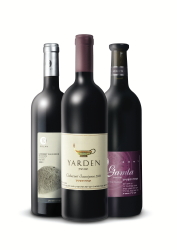 On the first night of Rosh Hashanah after the evening prayer, it is the Ashkenazi and Hasidic custom to wish Le’shana Tova Tikoseiv Vesichoseim (Le’Alter LeChaim Tovim U’Leshalom) which is Hebrew for „May you (immediately) be inscribed and sealed for a Good Year (and for a Good and Peaceful Life)”. This year we wished ourelves Le’shana Tova Tikoseiv Vesichoseim on Semptember 3rd, 2013.
On the first night of Rosh Hashanah after the evening prayer, it is the Ashkenazi and Hasidic custom to wish Le’shana Tova Tikoseiv Vesichoseim (Le’Alter LeChaim Tovim U’Leshalom) which is Hebrew for „May you (immediately) be inscribed and sealed for a Good Year (and for a Good and Peaceful Life)”. This year we wished ourelves Le’shana Tova Tikoseiv Vesichoseim on Semptember 3rd, 2013.
Shanah Tovah is the traditional greeting on Rosh Hashanah which in Hebrew means „A Good Year.” (Hebrew: שנה טובה).
Rosh Hashanah meals usually include apples and honey, to symbolize a sweet new year. Other foods with a symbolic meaning may be served, depending on local minhag („custom”), such as the head of a fish (to symbolize the „head” of the year).
Many communities hold a „Rosh Hashanah seder” during which blessings are recited over a variety of symbolic dishes.The blessings start with the phrase „Yehi ratzon,” meaning „May it be thy will.” In many cases, the name of the food in Hebrew or Aramaic represents a play on words (a pun). The Yehi Ratzon platter may include apples (dipped in honey, baked or cooked as a compote called mansanada); dates; pomegranates; black-eyed peas; pumpkin-filled pastries called rodanchas; leek fritters called keftedes de prasa; beets; and a whole fish with the head intact. It is also common to eat stuffed vegetables called legumbres yaprakes.
Some of the symbolic foods eaten are dates, black-eyed peas, leek, spinach and gourd, all of which are mentioned in the Talmud. Pomegranates are used in many traditions, to symbolize being fruitful like the pomegranate with its many seeds.The use of apples and honey, symbolizing a sweet year, is a late medieval Ashkenazi addition, though it is now almost universally accepted. Typically, round challah bread is served, to symbolize the cycle of the year.
